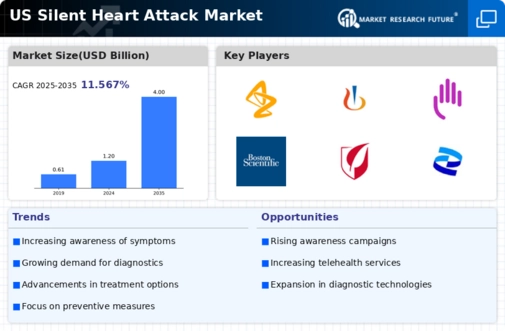Healthcare Policy Reforms and Funding
Recent healthcare policy reforms in the US are shaping the landscape of the silent heart-attack market. Increased funding for cardiovascular health initiatives and preventive care programs is likely to enhance access to diagnostic services. The Affordable Care Act has expanded coverage for preventive screenings, which may include tests for silent heart attacks. This policy shift suggests a potential increase in the number of individuals receiving timely evaluations, thereby facilitating early detection. As healthcare systems adapt to these reforms, the silent heart-attack market may witness growth driven by improved access to care and heightened awareness of cardiovascular health.
Increased Focus on Health and Wellness
There is a growing emphasis on health and wellness among the US population, which is likely to impact the silent heart-attack market positively. Consumers are becoming more health-conscious, seeking preventive measures to avoid serious health issues, including heart disease. This trend is reflected in the rising demand for health screenings and diagnostic tests. According to recent surveys, approximately 70% of adults express interest in regular health check-ups, which may include assessments for silent heart attacks. As individuals prioritize their health, the silent heart-attack market may experience increased demand for educational resources and diagnostic services.
Aging Population and Increased Risk Factors
The aging population in the US is a crucial factor impacting the silent heart-attack market. As individuals age, the risk of cardiovascular diseases escalates, with older adults being more susceptible to silent heart attacks. By 2030, it is estimated that 20% of the US population will be over 65 years old, a demographic that typically experiences higher rates of heart-related issues. This demographic shift necessitates a greater emphasis on monitoring and preventive measures, thereby expanding the silent heart-attack market. Healthcare systems may need to adapt by implementing targeted screening programs for older adults, which could further stimulate market growth.
Rising Incidence of Cardiovascular Diseases
The increasing prevalence of cardiovascular diseases in the US is a primary driver for the silent heart attack market. Statistics indicate that nearly 697,000 individuals succumb to heart disease annually, highlighting a critical health concern. This alarming trend suggests that more individuals may experience silent heart attacks, which often go undetected. As awareness grows regarding the asymptomatic nature of these events, healthcare providers are likely to focus more on early detection and intervention strategies. Consequently, this rising incidence is expected to propel demand for diagnostic tools and monitoring devices within the silent heart-attack market, as patients and healthcare professionals seek to mitigate risks associated with undiagnosed heart conditions.
Technological Innovations in Cardiac Monitoring
Technological advancements in cardiac monitoring devices are significantly influencing the silent heart-attack market. Innovations such as wearable ECG monitors and mobile health applications are becoming increasingly prevalent, allowing for continuous monitoring of heart health. These devices can detect irregular heart rhythms and other indicators that may suggest a silent heart attack. The market for wearable health technology is projected to reach $60 billion by 2025, indicating a robust growth trajectory. As these technologies become more accessible and affordable, they are likely to enhance patient engagement and encourage proactive health management, thereby driving the silent heart-attack market forward.






















Leave a Comment